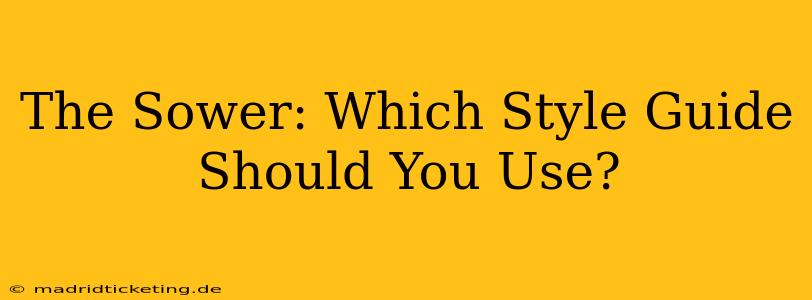The Sower: Which Style Guide Should You Use?
Choosing the right style guide for your writing, especially a significant piece like "The Sower," depends heavily on your intended audience and publication platform. There's no single "right" answer, but understanding the strengths of different style guides will help you make the best decision. Let's explore some popular options and their suitability for a work like "The Sower," assuming it's a piece of literary fiction or a detailed biblical analysis.
What are the most common style guides?
Several prominent style guides exist, each with its own nuances and conventions. The most common include:
-
Chicago Manual of Style (CMOS): Known for its comprehensive approach, CMOS is frequently used for academic writing, books, and literary works. It offers detailed guidance on grammar, punctuation, citation, and manuscript preparation. Its flexibility allows for adaptation to various genres, making it a suitable choice for a nuanced work like "The Sower." Its strength lies in its detailed explanations and its adaptability to different types of writing.
-
MLA Handbook: Primarily used in humanities disciplines, particularly literature and language studies, the MLA style guide focuses on in-text citations and a "Works Cited" page. While less comprehensive than CMOS in its overall stylistic guidance, it's a strong choice if your "Sower" analysis heavily relies on literary criticism and references.
-
AP Stylebook: The Associated Press style guide is widely adopted by journalists and news organizations. Its focus on brevity, clarity, and consistency makes it less suitable for a piece of literary fiction or a detailed theological analysis of "The Sower." The conciseness demanded by AP style might hinder the expression of nuanced interpretations.
-
Modern Language Association (MLA) Style Guide: Often used for literary analysis, the MLA style guide prioritizes clear attribution and avoids overly formal tones. It's better suited for scholarly work analyzing "The Sower" than for the creative writing of a fictional retelling.
Which style guide is best for a literary interpretation of "The Sower"?
For a literary interpretation or a detailed analysis of the parable of "The Sower" (found in Matthew 13 and other gospels), the Chicago Manual of Style offers the most comprehensive and flexible framework. Its detailed explanations of grammar, punctuation, and citation will allow for the expression of complex ideas and detailed textual analysis. The flexibility of CMOS also accommodates the varying needs of both creative writing (if your "Sower" is a fictional work) and scholarly analysis.
If your "Sower" project is more explicitly academic and relies heavily on critical theory or other scholarly sources, the MLA Handbook could be a suitable alternative. However, CMOS's broader scope often makes it the preferred choice for works of this nature.
What if "The Sower" is a work of fiction inspired by the parable?
If your "Sower" is a work of fiction inspired by the parable, the stylistic choices are more dependent on your personal preferences and the publisher's guidelines (if you're seeking publication). However, even in fiction, maintaining consistent and clear writing is paramount. While AP Style is less suitable, CMOS could still provide a valuable reference for ensuring grammatical accuracy and consistency in your narrative style.
How do I choose?
Consider these factors:
- Audience: Who are you writing for? Academics? General readers? A specific publisher?
- Genre: Is it fiction, non-fiction, literary criticism, or theological analysis?
- Publication: Will it be published by a journal, a book publisher, or self-published online? (Publishers often specify preferred styles.)
- Complexity: How detailed and nuanced is your analysis or narrative?
Ultimately, the best style guide is the one that best serves your needs and helps you communicate your ideas clearly and effectively. If in doubt, prioritize consistency and clarity above all else.

